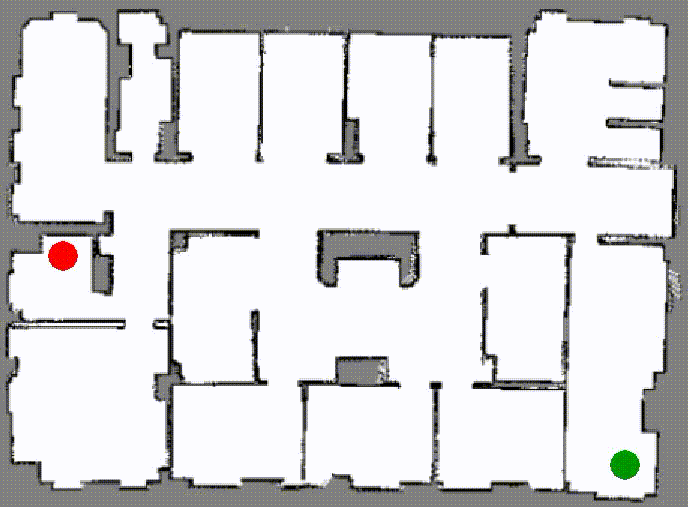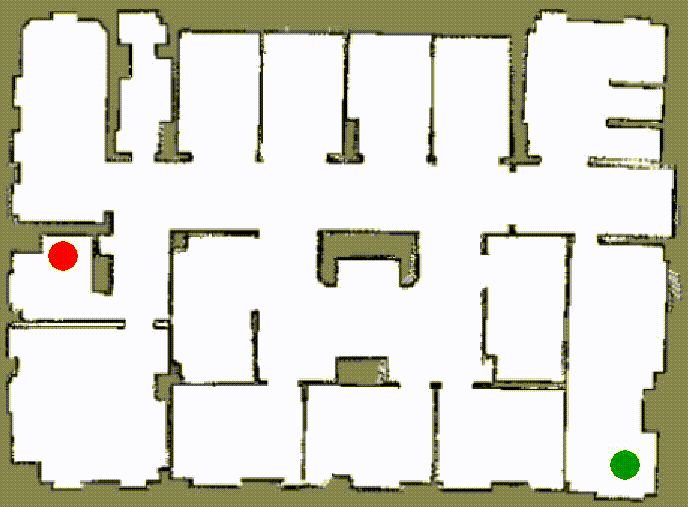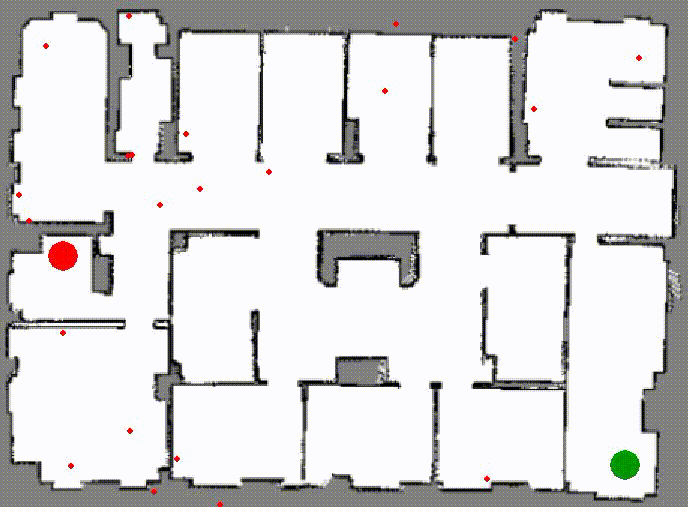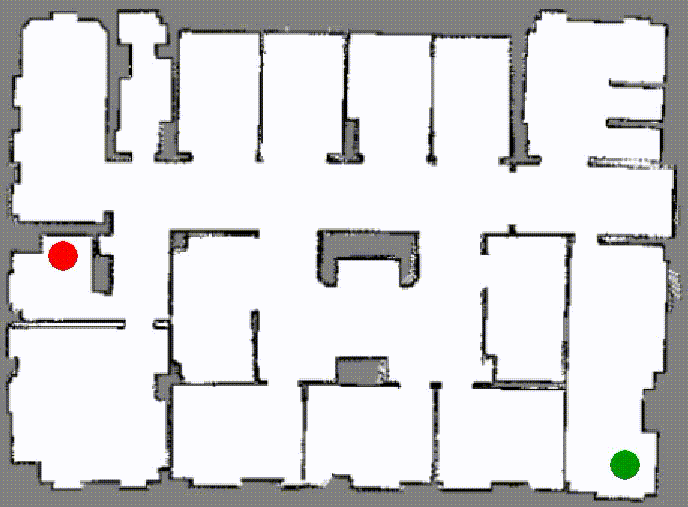Motion Planners
The following are all of the available motion planners in sbp-env.
RRT*

- class sbp_env.planners.rrtPlanner.RRTPlanner(args)[source]
Bases:
PlannerThe Rapidly-exploring random tree.
Rapidly-exploring Random Tree* (RRT*) is an anytime, asymptotic optimal sampling-based motion planner that continuously updates its solution within the given budget. The planner itself is implemented in
RRTPlanner, while the default sampling policy is implemented inRandomPolicySampler.- Parameters
args (PlanningOptions) –
- choose_least_cost_parent(newnode, nn=None, nodes=None, skip_optimality=False, use_rtree=False, poses=None)[source]
Given a new node, a node from root, return a node from root that has the least cost (toward the newly added node)
- Parameters
newnode (
Node) – the newly created node that we want to search for a new parentnn (
Optional[Node], optional) – the current closest node, optional.Default:Nonenodes (
Optional[List[Node]], optional) – the list of node to search againstDefault:Noneskip_optimality (
bool, optional) – skip searching for optimality (i.e. non-asymptomatic)Default:Falseuse_rtree (
bool, optional) – whether use rtree to store tree or notDefault:Falseposes (
Optional[List[ndarray]], optional) – list of configurations, with the same length asnodesDefault:None- Return type
- Returns
the node with the lowest cost
- static find_nearest_neighbour_idx(pos, poses)[source]
Find the nearest neighbour from the list of nodes
- init(**kwargs)[source]
The delayed initialisation function
- Parameters
start_pt (numpy.ndarray) – the start configuration
goal_pt (numpy.ndarray) – the goal configuration
- rewire(newnode, nodes, already_rewired=None, skip_optimality=False, use_rtree=True, poses=None)[source]
Rewire the given new node
- Parameters
newnode (
Node) – the newly created node that we want to rewiresalready_rewired (
Optional[bool], optional) – if the node had already been rewired previouslyDefault:Noneskip_optimality (
bool, optional) – skip optimality to speed up (reduce to RRT as opposed to RRT*)Default:Falseuse_rtree (
bool, optional) – if we should use rtree as opposed to native numpy operationsDefault:Trueposes (
Optional[ndarray], optional) – an array of positionsDefault:None- run_once()[source]
Execute the main planning procedure once (mostly of the time this corresponds to adding one new node to the tree)
This where the main bulk of actions happens, e.g., creating nodes or edges.
The sampler is registered as follows
sampler_id = "random" planner_registry.register_sampler(sampler_id, sampler_class=RandomPolicySampler)
and the planner is registered as follows
planner_registry.register_planner( "rrt", planner_class=RRTPlanner, visualise_pygame_paint=pygame_rrt_paint, visualise_klampt_paint=klampt_rrt_paint, sampler_id="random", )
Bi-RRT*

- class sbp_env.planners.birrtPlanner.BiRRTPlanner(args)[source]
Bases:
RRTPlannerThe bidrectional RRT* planner, or sometimes it’s also referred to as the RRT-Connect*.
The class
BiRRTPlanneruses an adopted version of random policy sampler that makes it suitable for using in both the start and goal trees, which is implemented inBiRRTSampler.- Parameters
args (PlanningOptions) –
- init(**kwargs)[source]
The delayed initialisation function
- Parameters
start_pt (numpy.ndarray) – the start configuration
goal_pt (numpy.ndarray) – the goal configuration
The sampler is registered as follows
planner_registry.register_sampler( "birrt_sampler", sampler_class=BiRRTSampler, )
and the planner is registered as follows
planner_registry.register_planner( "birrt", planner_class=BiRRTPlanner, visualise_pygame_paint=pygame_birrt_planner_paint, visualise_klampt_paint=klampt_birrt_paint, sampler_id="birrt_sampler", )
RRdT*

- class sbp_env.planners.rrdtPlanner.RRdTPlanner(args)[source]
Bases:
RRTPlannerThe Rapidly-exploring Random disjointed-Trees. The RRdT* planner is implemented based on Lai et. al.’s 1 work. The main idea is that the planner keeps a pool of disjointed trees
\[\mathbb{T}=\{\mathcal{T}_\text{root}, \mathcal{T}_1, \ldots, \mathcal{T}_k\} \]where it consists of a rooted tree that connects to the \(q_\text{start}\) starting configuration, and \(k\) many disjointed trees that randomly explores C-Space. Each disjointed tree is modelled as an arm in the Multi-Armed Bandit problem, i.e. each \(\mathcal{T}_i\) has an arm \(a_i\), where the probability to draw each arm is dependent on its previous success as given by
\[\mathbb{P}(a_{i,t} \mid a_{i,t-1}, o_{t-1})\,\forall_{i\in\{1,...,k\}} \]with \(o_{t-1}\) as the arm \(a_i\)’s previous observation.
- 1
Lai, Tin, Fabio Ramos, and Gilad Francis. “Balancing global exploration and local-connectivity exploitation with rapidly-exploring random disjointed-trees.” 2019 International Conference on Robotics and Automation ( ICRA). IEEE, 2019.
- Parameters
args (PlanningOptions) –
- add_pos_to_existing_tree(newnode, parent_tree)[source]
Try to add pos to existing tree. If success, return True.
- connect_two_nodes(newnode, nn, parent_tree=None)[source]
Add node to disjoint tree OR root tree.
- Parameters
newnode (
Node) – the new node to connectsnn (
Optional[Node]) – a node from the existing tree to be connectedparent_tree (
Optional[DTreeType], optional) – if given, add newnode to this treeDefault:None- find_nearest_node_from_neighbour(node, parent_tree, radius)[source]
Given a tree, a node within that tree, and radius Return a list of cloest nodes (and its corresponding tree) within the radius (that’s from other neighbourhood trees)
- join_tree_to_root(tree, middle_node, root_tree_node)[source]
It will join the given tree to the root
- Parameters
tree (
DTreeType) – the disjointed tree to be added to root treemiddle_node (
Node) – the middle node that connects the disjointed tree and the root treeroot_tree_node (
Node) – a node from the root tree
- join_trees(tree1, tree2, tree1_node, tree2_node)[source]
Join the two given tree together (along with their nodes). It will delete the particle reference from the second tree. It will use RRT* method to add all nodes if one of the tree is the ROOT.
tree1_node & 2 represent the nodes that join the two tree together. It only matters currently to joining root tree to disjointed tree itself.
- Parameters
tree1 (
DTreeType) – disjointed tree 1 \(\mathcal{T}_1\)tree2 (
DTreeType) – disjointed tree 2 \(\mathcal{T}_2\)tree1_node (
Node) – a node from tree 1 \(v_1 \in \mathcal{T}_1\)tree2_node (
Node) – a node from tree 2 \(v_2 \in \mathcal{T}_2\)
- rrt_star_add_node(newnode, nn=None)[source]
This function perform finding optimal parent, and rewiring.
- Parameters
newnode (
Node) – the node to add to the treenn (
Optional[Node], optional) – an approximate of nearest nodeDefault:None- run_once()[source]
Execute the main planning procedure once (mostly of the time this corresponds to adding one new node to the tree)
This where the main bulk of actions happens, e.g., creating nodes or edges.
The sampler and planner is registered as follows
sampler_id = "rrdt_sampler" planner_registry.register_sampler( sampler_id, sampler_class=RRdTSampler, visualise_pygame_paint=pygame_rrdt_sampler_paint, visualise_pygame_paint_init=pygame_rrdt_sampler_paint_init, ) planner_registry.register_planner( "rrdt", planner_class=RRdTPlanner, visualise_pygame_paint=pygame_rrdt_planner_paint, visualise_klampt_paint=klampt_rrdt_planner_paint, sampler_id=sampler_id, )
Informedrrt-RRT*
The Informed-RRT* motion planning behaves similar to
sbp_env.planners.rrtPlanner .RRTPlannerbefore a first solution is found. After an initial solution is found, this planner uses an ellipses heuristic to speed up convergence rate of the resulting solution.
The bulk of the implementation occurs in
InformedRRTSampler. The Informed-RRT* is implemented by directly deriving the base motion planner asRRTPlanner, and registering its sampler as theInformedRRTSampler.The sampler is registered as follows
sampler_id = "informed_sampler" planner_registry.register_sampler( sampler_id, sampler_class=InformedSampler, visualise_pygame_paint=pygame_informed_sampler_paint, )
and the planner is registered as follows
planner_registry.register_planner( "informedrrt", planner_class=rrtPlanner.RRTPlanner, visualise_pygame_paint=rrtPlanner.pygame_rrt_paint, sampler_id=informedSampler.sampler_id, )
PRM*
- class sbp_env.planners.prmPlanner.PRMPlanner(args)[source]
Bases:
RRTPlannerProbabilistic Roadmap motion planner, the multi-query sampling-based planner.
- Parameters
args (PlanningOptions) –
- get_nearest_free(node, neighbours)[source]
Internal method to get the closest existing node that is free to connects to the given node.
- init(*argv, **kwargs)[source]
The delayed initialisation function
- Parameters
start_pt (numpy.ndarray) – the start configuration
goal_pt (numpy.ndarray) – the goal configuration
The sampler is registered as follows
sampler_id = "prm_sampler" planner_registry.register_sampler( sampler_id, sampler_class=PRMSampler, )
and the planner is registered as follows
planner_registry.register_planner( "prm", planner_class=PRMPlanner, visualise_pygame_paint=pygame_prm_planner_paint, visualise_pygame_paint_terminate=pygame_prm_planner_paint_when_terminate, visualise_klampt_paint=klampt_prm_paint, visualise_klampt_paint_terminate=klampt_prm_planner_paint_when_terminate, sampler_id=prmSampler.sampler_id, )
Likelihood Planner
Refers to
sbp_env.samplers.likelihoodPolicySampler.LikelihoodPolicySamplerfor details.The bulk of the implementation occurs in
LikelihoodPolicySampler. The Informed-RRT* is implemented by directly deriving the base motion planner asRRTPlanner, and registering its sampler as theLikelihoodPolicySampler.The sampler is registered as follows
sampler_id = "likelihood_sampler" planner_registry.register_sampler( sampler_id, sampler_class=LikelihoodPolicySampler, visualise_pygame_paint=pygame_likelihood_sampler_paint, visualise_pygame_paint_init=pygame_likelihood_sampler_paint_init, )
and the planner is registered as follows
planner_registry.register_planner( "likelihood", planner_class=rrtPlanner.RRTPlanner, visualise_pygame_paint=rrtPlanner.pygame_rrt_paint, sampler_id=likelihoodPolicySampler.sampler_id, )
Nearby Planner
Refers to
sbp_env.samplers.nearbyPolicySampler.NearbyPolicySamplerfor details.The sampler is registered as follows
sampler_id = "nearby_sampler" planner_registry.register_sampler( sampler_id, sampler_class=likelihoodPolicySampler.LikelihoodPolicySampler, visualise_pygame_paint=likelihoodPolicySampler.pygame_likelihood_sampler_paint, visualise_pygame_paint_init=likelihoodPolicySampler.pygame_likelihood_sampler_paint_init, )
and the planner is registered as follows
planner_registry.register_planner( "nearby", planner_class=rrtPlanner.RRTPlanner, visualise_pygame_paint=rrtPlanner.pygame_rrt_paint, sampler_id=nearbyPolicySampler.sampler_id, )
Mouse Planner
Refers to
sbp_env.samplers.mouseSampler.MouseSamplerfor details.The sampler is registered as follows
sampler_id = "mouse" planner_registry.register_sampler( sampler_id, sampler_class=MouseSampler, )
and the planner is registered as follows
planner_registry.register_planner( "mouse", planner_class=rrtPlanner.RRTPlanner, visualise_pygame_paint=rrtPlanner.pygame_rrt_paint, sampler_id=mouseSampler.sampler_id, )
Abstract Base Planner
There is also a special base planner that all motion planner should be derived from.
- class sbp_env.planners.basePlanner.Planner(args)[source]
Bases:
ABCAbstract base planner that does nothing by itself.
- Parameters
args (PlanningOptions) –